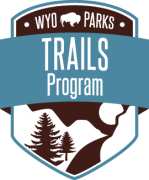Recently recognized by the Coalition for Recreational Trails (CRT) for the eleventh time, the Wyoming Trails Program has long been established as providing some of the best non-motorized and motorized trails in the region.
For the avid snowmobile user, off-road vehicle enthusiast, mountain biker, hiker, and equestrian the Trails program’s efforts are evident, but for members of the general public, it may not be apparent the number of hours and labor put into providing such a lucrative and valued recreational opportunity.
According to CRT, the organization is an alliance of national and regional trail-related organizations across a broad spectrum of interests representing motorized and non-motorized communities. Its members work together to build awareness and understanding of the Recreational Trails Program (RTP), which returns federal gasoline taxes paid by off-highway recreationists to the states for trail development.
Tax monies are distributed using a 30% motorized, 30% non-motorized, and 40% diversified equation to split up the state's allocated funding. A process that is overseen by the Wyoming State Trails Advisory Council, a 10-member board appointed by the Governor's office to represent a variety of trail uses
The Wyoming Trails program has previously been recognized by CRT in the categories of Communication and Education, Maintenance and Rehabilitation, Public and Private Partnerships, Environmental and Wildlife Compatibility, Multiple Use Management and Corridor Sharing, and this year for Construction and Design.
But what is it exactly that the Wyoming Trails Program does? Based in Lander, The Wyoming Trails Program maintains recreational trails statewide which is no easy task considering the Cowboy State ranks tenth in the nation in land mass at 97,813 square miles. Funding for these efforts is generated by snowmobile and ORV permits and federally by gasoline excise tax.
Due to the majority of the revenue being generated by motorized registration sales and fuel tax, the program is limited to solely the non-motorized portion of federal funding provided through RTP to fund non-motorized projects throughout the state, leaving a significant backlog in maintenance on non-motorized trails which expresses the need for other non-motorized funding mechanisms.
Beginning December 1, a staff of 26 employees – 12 full-time and 16 seasonal employees – began preparing for the upcoming snowmobile season by clearing deadfall and placing 44,000 temporary markers along 2,585 miles of snowmobile trails statewide along with maintaining them throughout the 4-month season. Those markers are then removed by April 15.
During the season, Wyoming Trails utilizes 29 Snowcats to groom eight major snowmobile systems encompassing 2,585 miles of trails. Grooming occurs overnight and involves a strategically choreographed schedule so trails are consistently and effectively maintained to provide the best user experience possible. All told, during the season 59,130 miles are groomed through private grooming contracts, while 33,000 miles are groomed utilizing internally owned equipment and seasonally hired operators. Those trails are 95 percent on Federal land involving mostly U.S. Forest Service and some Bureau of Land Management public lands. Although there is always a lot of work to be done, the program is dependent on the weather each year.
According to Wyoming Trails Program Manager Forrest Kamminga, there’s no such thing as too much snow, but being a 100% user funded program, a low snow season is the worst possible scenario
“If there’s a low snow season, we’re not generating enough revenue to cover the expenses,” he said.
And that doesn’t mean just for his program but also for Trailside Lodges and others involved in the snowmobile outdoor recreation industry.
The Summer season usually begins no later than mid-June depending on spring weather and involves maintaining the existing 840 miles of trail and the construction of new motorized trails. These trails heavily rely on federal land managing agency partnerships as 95% of the off-road vehicle (ORV) trails are on federal lands. On-the-ground work is completed by private contractors or by the 9 permanent trail crew members along with 16 seasonal employees.
A true pay-to-play endeavor, The Wyoming Trails Program generates approximately $4 million annually which, along with additional federal partnership match majority of the revenue generated goes to funding the agency’s operations. These funds are closely managed by the program's admin and grants staff through several internal grant funding mechanisms made available to federal, state, and local government land managing agencies, along with nonprofits that assist with several tasks including trail maintenance, signage, education, enforcement, and public safety outreach.
Every snowmobile permit generates $62.75 ($34 permit sales, $28.75 state fuel tax) with an average of 34,500 permits sold seasonally; and every ORV permit sold generates $32.50 ($14 permit sales, $18.50 state fuel tax.) with an average of 58,200 permits sold annually.
Like Wyoming’s State Park and Historic Sites, the state trail system is a major contributor to the state’s Tourism and Outdoor Recreation industries. Both motorized and non-motorized trail enthusiasts can agree these trails provide great recreational opportunities in the Cowboy State.

